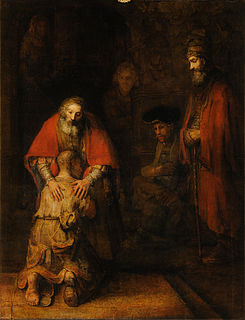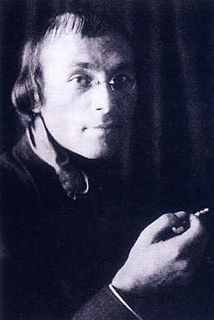A simile is a figure of speech that directly compares two things. Similes differ from metaphors by highlighting the similarities between two things through the use of words such as "like" and "as", while metaphors create an implicit comparison. This distinction is evident in the etymology of the words: simile derives from the Latin word similis, while metaphor derives from the Greek word metapherein. While similes are mainly used in forms of poetry that compare the inanimate and the living, there are also terms in which similes are used for humorous purposes and comparison.

A parable is a succinct, didactic story, in prose or verse that illustrates one or more instructive lessons or principles. It differs from a fable in that fables employ animals, plants, inanimate objects, or forces of nature as characters, whereas parables have human characters. A parable is a type of analogy.
figurative language is a distinction within some fields of language analysis, in particular stylistics, rhetoric, and semantics.

The telautograph, an analog precursor to the modern fax machine, transmits electrical impulses recorded by potentiometers at the sending station to servomechanisms attached to a pen at the receiving station, thus reproducing at the receiving station a drawing or signature made by the sender. It was the first such device to transmit drawings to a stationary sheet of paper; previous inventions in Europe had used rotating drums to make such transmissions.
In literature, an author uses contrast when he or she describes the difference(s) between two or more entities. For example, in the first four lines of William Shakespeare's Sonnet 130, Shakespeare contrasts a mistress to the sun, coral, snow, and wire.

Clément Pansaers was the main proponent of the Dada movement in Belgium.

The Cotton States and International Exposition Speech was an address on the topic of race relations given by Booker T. Washington on September 18, 1895. The speech laid the foundation for the Atlanta compromise, an agreement between African-American leaders and Southern white leaders in which Southern blacks would work meekly and submit to white political rule, while Southern whites guaranteed that blacks would receive basic education and due process of law.
Equative is a case prototypically expressing the standard of comparison of equal values. The equative case has been used in very few languages in history. It was used in the Sumerian language, where it also took on the semantic functions of the essive case and similative case.
Hypocatastasis is a figure of speech that declares or implies a resemblance, representation or comparison. It differs from a metaphor, because in a metaphor the two nouns are both named and given; while, in hypocatastasis, only one is named and the other is implied, or as it were, is put down underneath out of sight. Hence hypocatastasis is an implied resemblance or representation: that is an implied simile or metaphor. A hypocatastasis has more force than a metaphor or simile, and expresses as it were a superlative degree of resemblance.
A simile is a figure of speech making an explicit comparison.

Founded in 1969, Toulouse Institute of Technology is a French university cluster based in Toulouse, France, part of University of Toulouse. The Institute is composed of seven schools and 17 research laboratories. The Institute delivers master's degrees and Ph.D. It is a member of Institut au service du spatial, de ses applications et technologies.
SIMILE was a joint research project run by the World Wide Web Consortium (W3C), Massachusetts Institute of Technology Libraries and MIT CSAIL and funded by the Andrew W. Mellon Foundation. The project ran from 2003 to August 2008. It focused on developing tools to increase the interoperability of disparate digital collections. Much of SIMILE's technical focus is oriented towards Semantic Web technology and standards such as Resource Description Framework (RDF).
Exhibit is a lightweight, structured-data publishing framework that allows developers to create web pages with support for sorting, filtering and rich visualizations. Oriented towards semantic web-type problems, Exhibit can be implemented by writing rich data out to HTML then configuring some CSS and JavaScript code.

Sonnet 84 is one of 154 sonnets published by the English playwright and poet William Shakespeare in 1609. It's part of the Fair Youth sequence, and the seventh sonnet of the Rival Poet group.
Homeric simile, also called an epic simile, is a detailed comparison in the form of a simile that are many lines in length. The word "Homeric", is based on the Greek author, Homer, who composed the two famous Greek epics, the Iliad and the Odyssey. Many authors continue to use this type of simile in their writings although it is usually found in classics.
Ullurai is a type of extended allusion or metaphor used in classical Tamil poetry.
Roepera similis is a succulent annual herb native to Australia.

An animal epithet is a name used to label a person or group, by association with some perceived quality of an animal. Epithets may be formulated as similes, explicitly comparing people with the named animal, or as metaphors, directly naming people as animals. Animal epithets may be pejorative, readily giving offence, and they are sometimes used in political campaigns. One English epithet, lamb, is always used positively.

Comparison or comparing is the act of evaluating two or more things by determining the relevant characteristics of each thing to be compared, and then determining which characteristics of each are similar to the other, which are different, and to what degree. Where characteristics are different, the differences may then be evaluated to determine which thing is best suited for a particular purpose. The description of similarities and differences found between the two things is also called a comparison. Comparison can take many distinct forms, varying by field:
To compare is to bring two or more things together and to examine them systematically, identifying similarities and differences among them. Comparison has a different meaning within each framework of study. Any exploration of the similarities or differences of two or more units is a comparison. In the most limited sense, it consists of comparing two units isolated from each other.

Panicum simile, known by the common name two colour panic, is a species of grass found in eastern Australia. It was described by Karel Domin in 1915.













